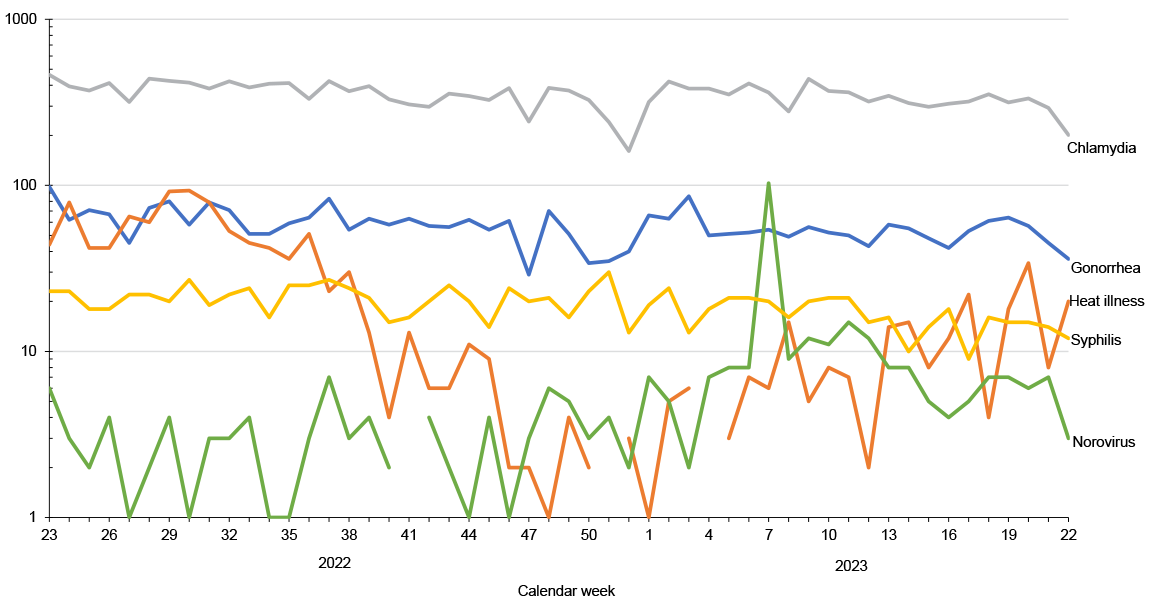Reportable Medical Events, Military Health System Facilities, Week 22, Ending June 3, 2023
 Graph depicting the frequency of the five most common reportable medical events within the Military Health System over the preceding year.
Graph depicting the frequency of the five most common reportable medical events within the Military Health System over the preceding year.
Reportable Medical Events are documented in the Disease Reporting System internet by health care providers and public health officials across the Military Health System for the purpose of monitoring, controlling, and preventing the occurrence and spread of diseases of public health interest or readiness importance. These reports are reviewed by each service’s public health surveillance hub. The DRSi collects reports on over 70 different RMEs, including infectious and non-infectious conditions, outbreak reports, STI risk surveys, and tuberculosis contact investigation reports. A complete list of RMEs is available in the 2022 Armed Forces Reportable Medical Events Guidelines and Case Definitions.1 Data reported in these tables are considered provisional and do not represent conclusive evidence until case reports are fully validated.

Total active component cases reported per week are displayed for the top five RMEs for the previous year. Each month, the graph is updated with the top five RMEs, and is presented with the current month’s (May 2023) top five RMEs, which may differ from previous months. COVID-19 is excluded from these graphs due to changes in reporting/case definition updates in 2023.

References
- Armed Forces Health Surveillance Division. Armed Forces Reportable Medical Events. Accessed April 6, 2023. https://www.health.mil/Military-Health-Topics/Health-Readiness/AFHSD/Reports-and-Publications/Armed-Forces-Reportable-Medical-Events
- Defense Manpower Data Center. Department of Defense Active Duty Military Personnel by Rank/Grade of Service, October 31, 2022. https://dwp.dmdc.osd.mil/dwp/app/dod-data-reports/workforce-reports
- Defense Manpower Data Center. Armed Forces Strength Figures for January 31, 2023. https://dwp.dmdc.osd.mil/dwp/app/dod-data-reports/workforce-reports
- Navy Medicine. Surveillance and Reporting Tools–DRSI: Disease Reporting System Internet. https://www.med.navy.mil/Navy-Marine-Corps-Public-Health-Center/Preventive-Medicine/Program-and-Policy-Support/Disease-Surveillance/DRSI
You also may be interested in...
Report
Jul 1, 2019
 .PDF |
4.86 MB
.PDF |
4.86 MB
A monthly publication of the Armed Forces Health Surveillance Branch. This issue of the peer-reviewed journal contains the following articles: Modeling Lyme disease host animal habitat suitability, West Point, New York; Incidence, timing, and seasonal patterns of heat illnesses during U.S. Army basic combat training, 2014–2018; Update: Heat illness, ...
Article
Jul 1, 2019
Infectious Mononucleosis, Active Component, U.S. Armed Forces, 2002–2018
Article
Jul 1, 2019
Case Report: Possible Psittacosis in a Military Family Member—Clinical and Public Health Management Issues in Military Settings
Article
Jul 1, 2019
Zika Virus Surveillance in Active Duty U.S. Military and Dependents Through the Naval Infectious Diseases Diagnostic Laboratory
Article
Jul 1, 2019
As in prior years, mental health disorders, pregnancy-related conditions, and injury/poisoning accounted for the majority (59.8%) of all hospitalizations among active component service members in 2018. However, the hospitalization rate for all causes was the lowest rate in the past 10 years.
Article
Jul 1, 2019
Brief Report: Department of Defense Midseason Estimates of Vaccine Effectiveness for the 2018–2019 Influenza Season
Report
Jun 1, 2019
 .PDF |
5.16 MB
.PDF |
5.16 MB
A monthly publication of the Armed Forces Health Surveillance Branch. This issue of the peer-reviewed journal contains the following articles: Modeling Lyme disease host animal habitat suitability, West Point, New York; Incidence, timing, and seasonal patterns of heat illnesses during U.S. Army basic combat training, 2014–2018; Update: Heat illness, ...
Article
Jun 1, 2019
As in prior years, mental health disorders, pregnancy-related conditions, and injury/poisoning accounted for the majority (59.8%) of all hospitalizations among active component service members in 2018. However, the hospitalization rate for all causes was the lowest rate in the past 10 years.
Article
Jun 1, 2019
As in prior years, mental health disorders, pregnancy-related conditions, and injury/poisoning accounted for the majority (59.8%) of all hospitalizations among active component service members in 2018. However, the hospitalization rate for all causes was the lowest rate in the past 10 years.
Article
Jun 1, 2019
Diarrheal illnesses have an enormous impact on military operations in the deployed and training environments. While bacteria and viruses are the usual causes of gastrointestinal disease outbreaks, 2 Joint Base San Antonio–Lackland, TX, training populations experienced an outbreak of diarrheal illness caused by the parasite Cyclospora cayetanensis in ...
Article
Jun 1, 2019
The natural human sex ratio at birth (male:female) slightly favors males, and altered sex ratios might be indicative of exposure to reproductive hazards.
Article
Jun 1, 2019
The U.S. Millennium Cohort Study is a population-based prospective study that includes over 200,000 current and prior U.S. military service members.
Report
May 1, 2019
 .PDF |
5.75 MB
.PDF |
5.75 MB
A monthly publication of the Armed Forces Health Surveillance Branch. This issue of the peer-reviewed journal contains the following articles: Modeling Lyme disease host animal habitat suitability, West Point, New York; Incidence, timing, and seasonal patterns of heat illnesses during U.S. Army basic combat training, 2014–2018; Update: Heat illness, ...
Article
May 1, 2019
Musculoskeletal disorders and mental health disorders accounted for more than half (52.6%) of all illness- and injury-related ambulatory encounters among active component service members in 2018. Since 2014, the number of ambulatory visits for mental health disorders has decreased, while the numbers of ambulatory visits for musculoskeletal system ...
Article
May 1, 2019
The number of medical evacuations for battle injuries has decreased considerably since 2014. Most medical evacuations in 2018 were attributed to mental health disorders, followed by non-battle injury/poisoning; signs, symptoms, and ill-defined conditions; musculoskeletal disorders; and digestive system disorders.
You are leaving Health.mil
The appearance of hyperlinks does not constitute endorsement by the Department of Defense of non-U.S. Government sites or the information, products, or services contained therein. Although the Defense Health Agency may or may not use these sites as additional distribution channels for Department of Defense information, it does not exercise editorial control over all of the information that you may find at these locations. Such links are provided consistent with the stated purpose of this website.
You are leaving Health.mil
View the external links disclaimer.
Last Updated: August 24, 2023